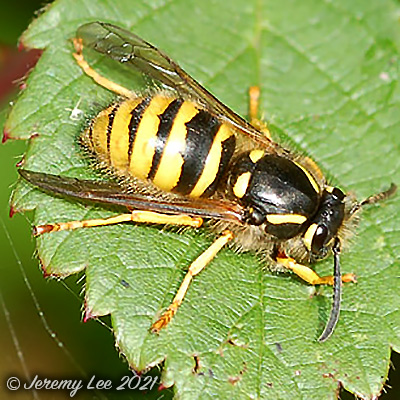
 |
|
Scientific Classifications explained » Amphibians » Ants » Aphids » Bees » Beetles » Birds » Bugs » Butterflies » Caterpillars » Damselflies » Dragonflies » Earwigs » Flies » Frog/Leafhoppers » Fungi » Galls » Grasshoppers » Harvestmen » Hoverflies » Lacewings » Ladybirds » Leaf Mines » Lichens » Mammals » Millipedes » Mosses » Moths » Sawflies » Slugs » Snails » Spiders » Trees & Shrubs » Wasps » Wild Flowers » Woodlice » Postboxes |
UK Nature > Wasps > Dolichovespula sylvestris

Scientific Name: Dolichovespula sylvestris Common Name: Tree Wasp Dolichovespula sylvestris, despite being called the tree wasp, builds both aerial and underground paper nests, and can be found in rural and urban habitats. It is locally common and can be very aggressive to perceived predators, including humans. About 22 millimetres in length, the face of this species is usually clear yellow with a single dot. The antennae are yellow at the base. Thorax with lateral hairs and two posterior yellow spots. It builds its nest in trees and other aerial sites as well as underground. Around 20% of nests are constructed underground but normally near the surface in a pre-existing cavity, as opposed to burrowing. Aerial nests have been found up to 8.3 metres off the ground, usually in enclosed spaces such as bird boxes, hollow trees, cavity walls etc., although exposed nests have been found in places where they are sheltered, e.g. in buildings. The flight period begins in March and lasts into September. |
|

https://www.uknature.co.uk is a website dedicated to showing the immense diversity of UK nature and wildlife. Our vast range of habitats, from lowland arable to snow covered mountains, from storm-ravaged coastlines to peaceful inland freshwater lakes and rivers, from dry, sandy heaths to deciduous and coniferous forests, all these habitats contribute to the abundance of UK nature. We have wild birds in huge numbers either residing or visiting our shores (597 recorded species as at July 2013) and we must also not forget the humble back garden with its grass lawns, flower beds filled with nectar rich flowers, shrubs and trees, all designed to attract huge numbers of insects such as bees, moths, butterflies and hoverflies; and finally the small ponds which provide safe havens for frogs, toads, newts and even slow worms and grass snakes. www.uknature.co.uk is the showcase for my personal passion, photographing uknature in all its glory. I sincerely hope you all enjoy the fruits of my labours. This site and all images contained therein is © Jeremy Lee 2004 - 2025. All Rights Reserved. Site design by Jeremy Lee. Site development & IT Support by Stuart Lee. |